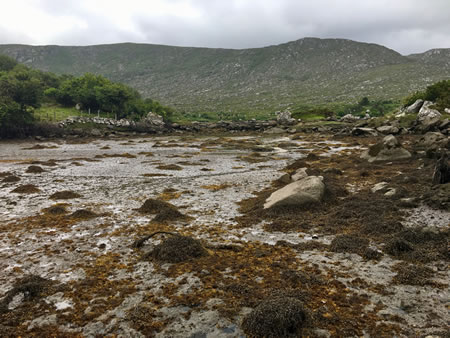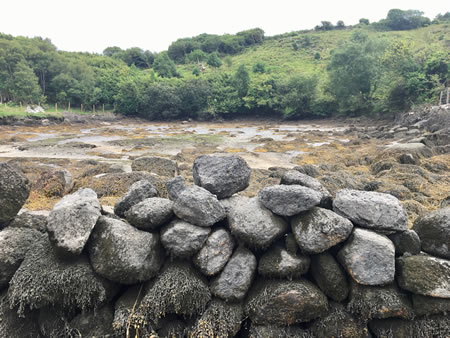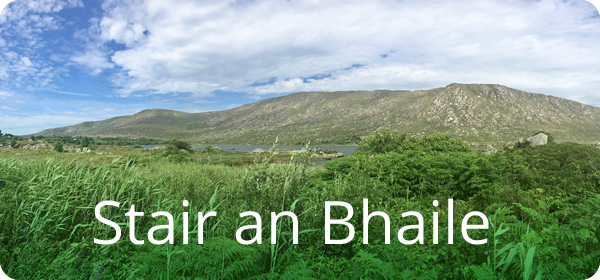Bunús an Bhaile
Ar ndóigh ní bheidh fios go brách againn cén bunús a bhí leis an mbaile, nó cén fáth gar tháinig daoine go Loch Con Aortha an chéad lá riamh. Tá sé deacair aon tuairiscí scríofa faoin mbaile a fháil roimh an 19ú haois. Tá a fhios againn go raibh daoine éigin ina gcónaí sa taobh thiar den pharóiste am éigin idir 400AD agus 1100AD mar gheall ar na crannóga a thóg siad ar Loch Scainimh, Loch Buaile agus Loch Dhúleitir. B’fhéidir gur sheas siad ar bharr Chnoc Mordáin ar an mbealach ann dóibh!
De réir na staire bhí ceantar Iorras Aithneach faoi smacht ag na Flathartaigh. In 1585 tugadh an ceantar seo do Thadhg na Buile Ó Flathartaigh agus thóg sé caisleán san áit a dtugtar Aird an Chaisleáin air anois. Bhí 15 bhád aige agus bhíodh sé ag trádáil chomh fada leis an Spáinn. Ba oisrí is mó a bhíodh sé a thabhairt ann, rudaí a bhí an-fhairsing sna cuanta timpeall air anseo, agus thugadh sé snaoisín, fíon, srl, ar ais leis. Tá sé ráite go bhfágfadh Tadhg na Buile cuid do na báid feistithe le linn an Gheimhridh san áit ar a dtugtar Crompán Thaidhg anois i gCoill Sáile.
Bhíodh trádáil oscailte le tíortha eile ag dul ar aghaidh sa gceantar go dtí go dtáinig an “Act of Union” isteach in 1801. Tar éis sin, gan clárú agus ceadúnas, bhí sé mí-dhleathach aon trádáil a dhéanamh. D’iompaigh go leor bádóirí as an áit seo ar smuigléireacht, agus bádóir ar bith a ghabhfaí chailleadh sé an bád agus a shaoirse.
Tá beagán eolais scríofa faoin mbealach ar mhair agus ar chónaigh daoine in Éirinn sa 17ú haois
THE CONNAUGHT JOURNAL
THURSDAY, JULY 23, 1840
THE IRISH IN 1644
AS DESCRIBED BY A FRENCHMAN OF THAT PERIOD
(From the Irish Penny Journal)
We are indebted to our talented countryman, Crofton Croker, for the translation of the tour of a French traveller, M. De la Boulfaye Le Gouz, in Ireland in 1644. Its author journeyed from Dublin to the principal cities and towns in Ireland, and sketches what he saw in a very amusing manner. The value of the publication, however, is greatly enhanced by the interesting notes appended to it by Mr. Croker and some of his friends; and as the work is less known in Ireland than it should be, we extract from it the Frenchman's sketch of the habits and customs of the Irish people as they prevailed two centuries back, in the belief that they will be acceptable to our readers.
"Ireland, or Hibernia, has always been called the Island of Saints, owing to the number of great men who have been born there. The natives are known to the English under the name of Iriche, to the French under that of Hibernois, which they take from the Latin, or Irois, from the English, or Irlandois from the name of the island, because land signifies ground. They call themselves Ayrenake, in their own language, a tongue which you must learn by practice, because they do not write it; they learn Latin in English characters, with which characters they also write their own language; and so I have seen a monk write, but in such a way as no one but himself could read it.
Saint Patrick was the apostle of this island, who according to the natives blessed the land, & gave his malediction to all venomous things; and it cannot be denied that the earth and the timber of Ireland, being transported, will contain neither serpents, worms, spiders, nor rats, as one sees in the west of England and Scotland, where all particular persons have their trunks and the boards of their floors in Irish wood; and in all Ireland there is not to be found a serpent or toad.
The Irish of the southern and eastern coasts follow the customs of the English; those of the north, the Scotch. The other are not very published, and are called by the English savages. The English colonists were of the English church, and the Scotch were Calvinists, but at present they are all Puritans. The native Irish are very good Catholics, though knowing little of their religion those of the Hebrides and of the North acknowledge only Jesus and St. Columbo (Columbkill), but their faith is great in the church of Rome. Before the English revolution, when an Irish gentleman died, his Britannic majesty became seised of the property and tutellage of the children of the deceased, whom they usually brought up in the English Protestant religion. Lord Insiquin (Inchiquin) was educated in this manner, to whom the Irish have given the name of plague or pest of this country.
The Irish gentlemen eat a great deal of meat and butter, and but little bread. They drink milk and beer, into which they put laurel leaves, and eat bread baked in the English manner. The poor grind barley and peas between two stones, and make it into bread, which they cook upon a small iron table heated on a tripod; they put into it some oats, and this bread, which is the form of cakes they call harann, they eat with great draughts of buttermilk. Their beer is very good and the eau de vie, which they call brandovin [brandy] excellent. The butter, the beef, and the mutton, are better than in England.
The towns are built in the English fashion, but the houses in the country are in this manner: - Two stakes are fixed in the ground, across which is a transverse pole to support two rows of rafters on the two sides, which are covered with straw and leaves. They are without chimneys and make the fire in the middle of the hut, which greatly incommodes those who are not fond of smoke. The castles or houses of the nobility consist of four walls extremely high, thatched with straw; but to tell the truth, they are nothing but square towers without windows, or at least having such small apertures as to give more light than there is in a prison. They have little furniture, and cover their rooms with rushes, of which they make their beds in summer, and of straw in winter. They put the rushes a foot deep on their floors, and on their windows, and many of them ornament the ceilings with branches.
They are fond of the harp, on which nearly all play, as the English do on the fiddle, the French on the lute, the Italians on the guitar, the Spaniards on its castanets, the Scotch on the bagpipe, the Swiss on the fife, the Germans on the trumpet, the Dutch on the tambourine, and the Turks on the flageolet.
The Irish carry a sequine [skein] or Turkish dagger, which they dart very adroitly at fifteen paces distance; and have this advantage, then if they remain masters of the field of battle, there remains no enemy; and if they are routed, they fly in such a manner that it is impossible to catch them. I have seen an Irishman, with ease accomplish twenty-five leagues a day. They march to battle with the bagpipes instead of fifes; but they have few drums, and they use the musket and cannon as we do. They are better soldiers abroad than at home.
The red-haired are considered the most handsome in Ireland. The women have hanging breasts; and those who are freckled, like a trout, are esteemed the most beautiful.
The trade of Ireland consists in salmon and herrings, which they take in great numbers. You have one hundred and twenty herrings for an English penny, equal to a carolus of France, in the fishing time. They import wine and salt from France, and sell there strong frize cloths at good prices.
The Irish are fond of strangers, and it costs little to travel amongst them. When a traveller of good address enters their houses with assurance, he has but to draw a box of sinisine, or snuff, and offer it to them; then these people receive him with admiration, and give him the best they have to eat. They love the Spaniards as their brothers, the French as their friends, the Italians as their allies, the Germans as their relatives, the English and Scotch as their irreconcileable enemies. I was surrounded on my journey from Kilkinik [Kilkenny] to Cachel [Cashel] by a detachment of twenty Irish soldiers; and when they learned I was a Frankard (it is thus they call us) they did not molest me in the least, but made me offers of service seeing that I was neither Sezanach [Saxon] nor English.
The Irish, whom the English call savages, have for their head-dress a little blue bonnet, raised two fingers-breadth in front and behind covering their head and ears. Their doublet has a long body and four skirts; and their breeches re a pantaloon of white frize, which they call sers. Their shoes, which are pointed, they call brogues, with a single sole. They often told me of a proverb in English, ' Airische borgues for English dugues' [Irish brogues for English dogs] ' the shoes of Ireland for the dogs of England', meaning that their shoes are worth more than the English.
For cloaks they have five or six yards of frize drawn around the neck, the body, and over the head, and they never quit this mantle, either in sleeping, working or eating.
The northern Irish have for their only dress a breeches, a covering for the back, without bonnets, shoes, or stockings. The women of the north have a double rug, girded round their middle and fastened to the throat. Those bordering on Scotland have not more clothing.- The girls of Ireland, even those living in towns, have for their head dress only a ribbon, and if married, they have a napkin on the head in the matter of Egyptians. The body of their gowns comes only to their breasts, and when they are engaged in work, they gird their petticoat with their sash about the abdomen. They wear a hat and mantle very large, of a brown colour [ coleur minime] of which the cape is of course woollen frize., in the fashion of the women of Lower Normandy."





